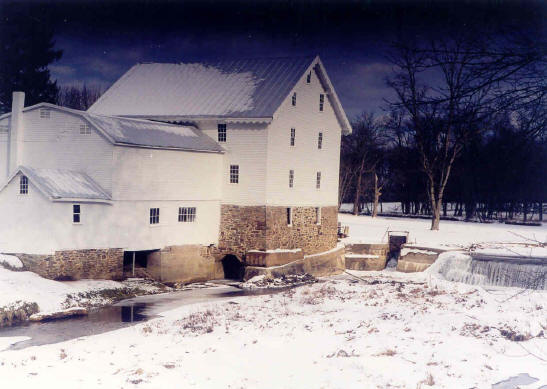|
Mill's of Old
Polly Shank
"One hand in the hopper and the
other in the sack,
the ladies step forward and gents
fall back."
The Mill, Mill stream, dam and race have long been
romanced by song writers, poets and articles. "Down
by the old mill stream," "When you and I were
young Maggis," "Happy as the Miller boy stands
by the Mill," and "The wheel goes around with
a free good will" were just a few on popular songs
sung in the milling days of old.

Otterdale Mill
Locals mill played a very important port in the
social life of long ago. Being the largest building in
the area, they were often the scene of community meeting
and a Parties. It was at Troxel’s Mill that the
original settlers of Emmitsburg came together and voted
their support of Independence.
In the summertime, the ponds that supplied water that
powered the mill were a prime choice for Church and
community picnics, but not for swimming. Girls,
completely clothed from head to ankle with no flesh
exposed, would have surely drowned if they had tried.
Boy, who had learned to swim in swimming holes in
streams, where un-accustomed to anything but skinny
dipping.
Instead, young girls and boys often went off fishing.
Men pitched horse shoes, and the ladies set out food in
the shade and exchanged recipes. This gave the older
boys a chance to invite their special to go boating and
little privacy.
In the winter, the mill’s ponds would freezes over
for months, providing an excellent ice-skating surface,
especially for young ladies, who used it as an
opportunity to show off their gracefulness as they
skated hand over hand, with their favorite young man.
During the short winter days, boys would gather a big
pile of brush and a good size log or tree trunk, which
they would light at dusk. The lighted brush pile made
light for skating and a place to gather. Talk, and warm
weary bones. The log provided a place to rest and a
place for the girls to sit while the boys adjusted their
skates. Unlike today’s modern one piece skates, we
wore substantial shoes laced above the ankle, with
skates clamped onto the shoes at the heel and at the
wide part of the shoe, all of which was tightened with a
key.
The exhausting of the fire signaled the end of the
night festivities, and slowly, one by one, exhausted
skaters retired to a home nearby to warm them mulled
cider and warm ginger bread, and on rare occasions,
popcorn, roast peanuts and sweet potatoes or pull taffy.
As they filled themselves with the fruits of their
labors of summer, they listened as their parents told
amusing tales of episodes of their days of old.
In the mills of
old, grain was ground chopped and mixed according to the
customers needs or wishes. Animals required a different grain
from others: Soybeans for dairy cows, oats for horses, corn for
hogs, mixed grains for chickens etc. These were mixed with other
grains and supplements in a large conical mixer that had a
scraping noise all its own. As most animals have a sweet tooth,
a hefty amount of sweet molasses was almost always added.
Once the grain was delivered,
the miller would turn the wheel that lifted the gate that
allowed water in. As the splash and swash of the water pours in,
the unbalanced wheel with pings and groan begins to turn. After
more water is turned on and the wheel maintains a steady pace
the big belt is slipped on and the whole operation begins. It is
very noisy; wheels turning, elevators in spouts carrying grain
to and fro, from bins to machinery.
The flour is made from locally
grown wheat. Large heavy steel rolls peel off the outer layer
‘the Bran’, which is directed to the bran bin. The next set
of rolls peels the middling or shorts, which are directed to
their own bin. The third roll crushes the heart of the wheat,
which is the flour. The flour is sifted through large silk
clothes, which vibrate is a slow, but constant motion. The
miller had to keep a close watch that all machinery ran
smoothly. Any changes of speed or sound meant trouble. The
miller ear was on the pulse of the mill.
Corn was ground into corn meal
on a stone burn. One stone was stationary the other revealed
corn grains were trickled only top center in a steady stream and
the speed of the grinding was timed to an Irish rhythm and the
smell was good. Some people brought their own special grist
which they had sorted carefully and toasted. The raising and
lowering of the burr was a tedious operation. When it was
lowered, it was in operation driven by a wheel of hand made
wooden cogs which were replaced at time. The burr itself was
picked each year to keep it sharp and the grooves open.
The office was the business and
social part of the mill. It was the only place quiet enough to
talk and do business. Here grain was bought and sold. Many
farmers borough a large amount of wheat or corn and got the
flour and cornmeal in exchange as they needed it. In the winter,
the wood stove made the office a cozy refuge from the cold, and
the row of chairs invited long and pleasant stays.
Have your own
memories of Emmitsburg Mills of Old?
If so, send them to us at history@emmitsburg.net
Back
to Previous Page >
|